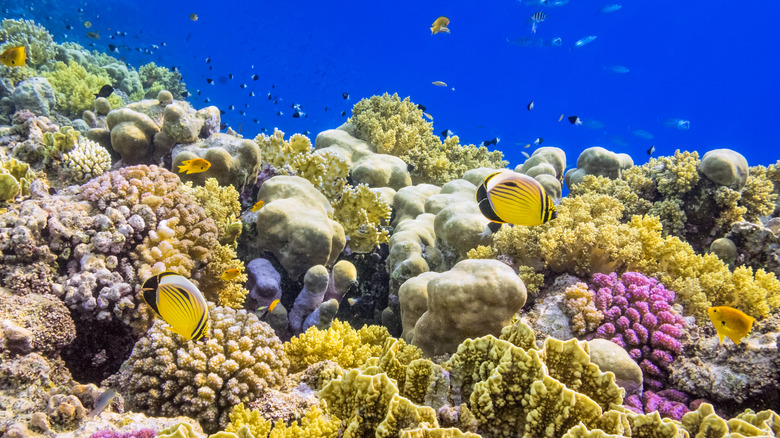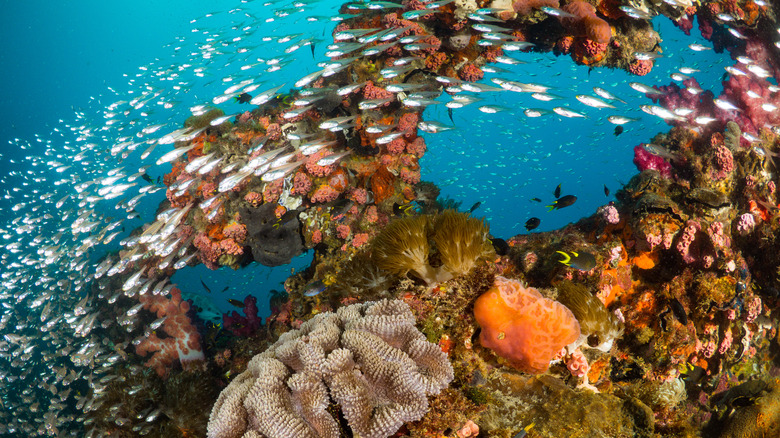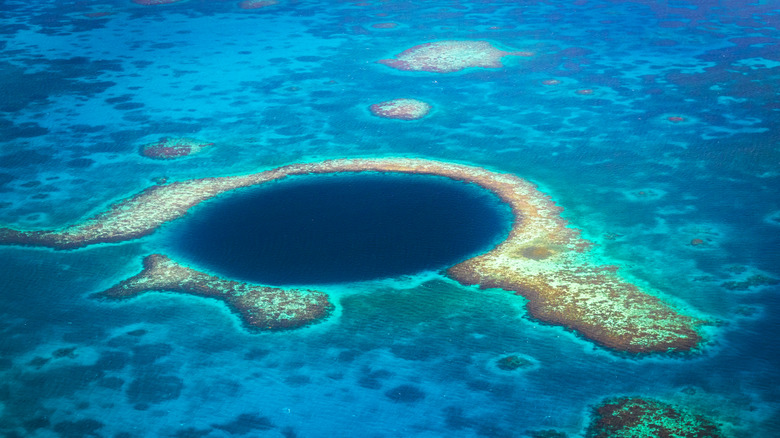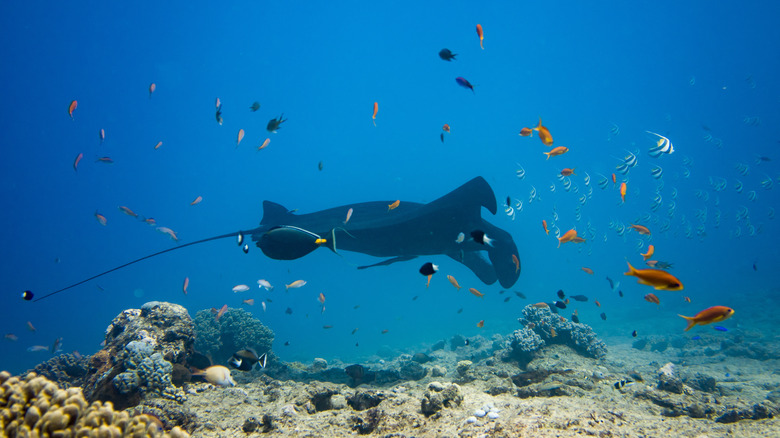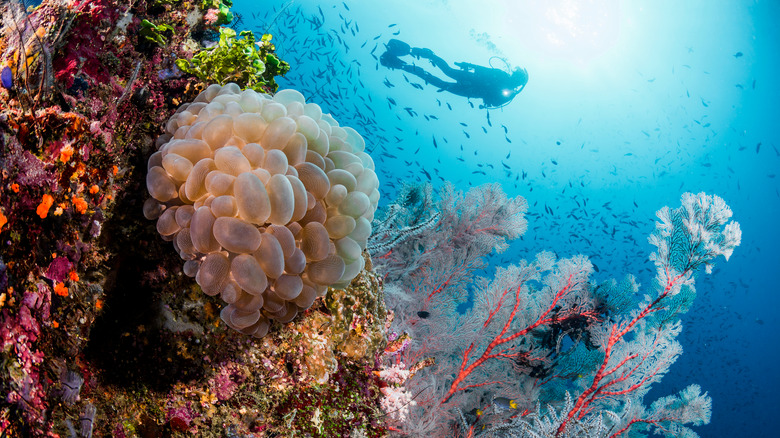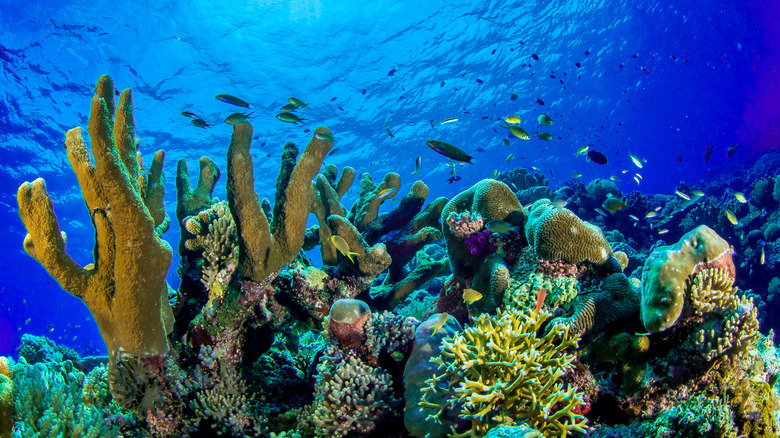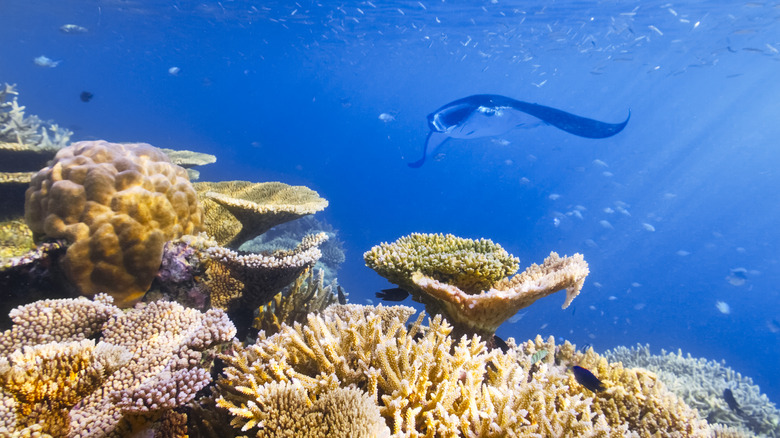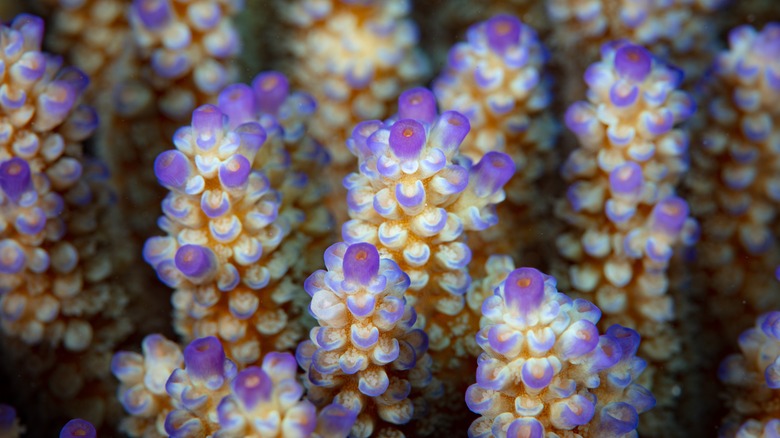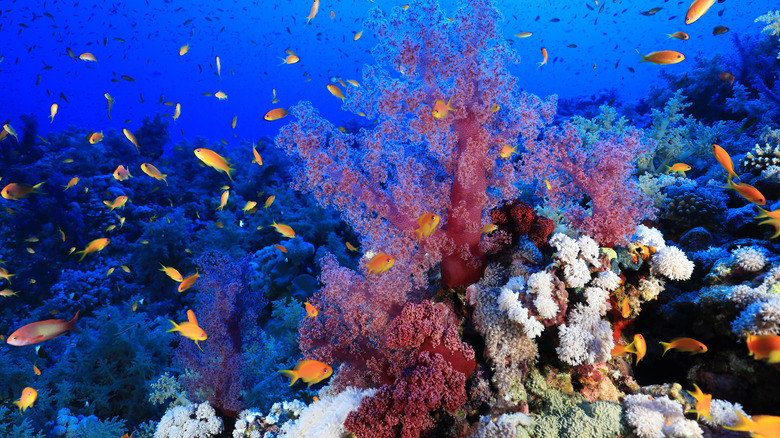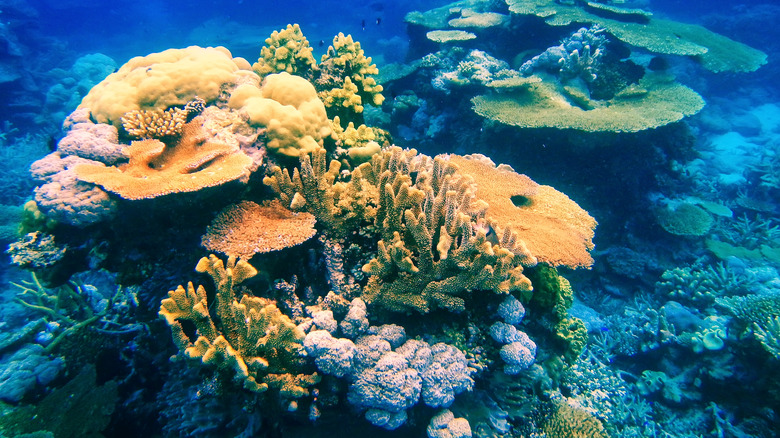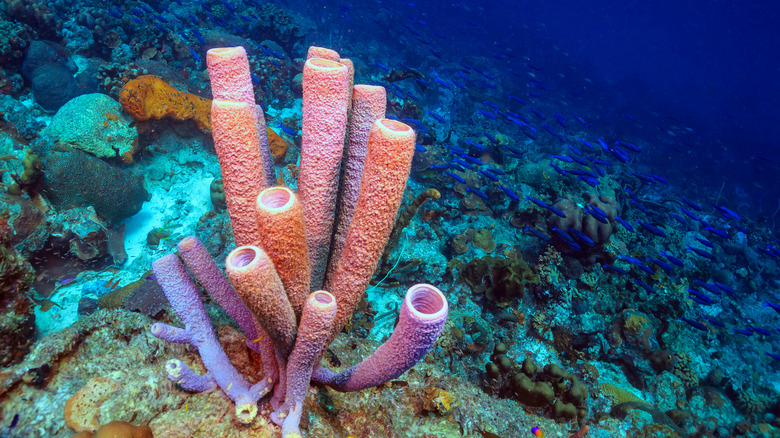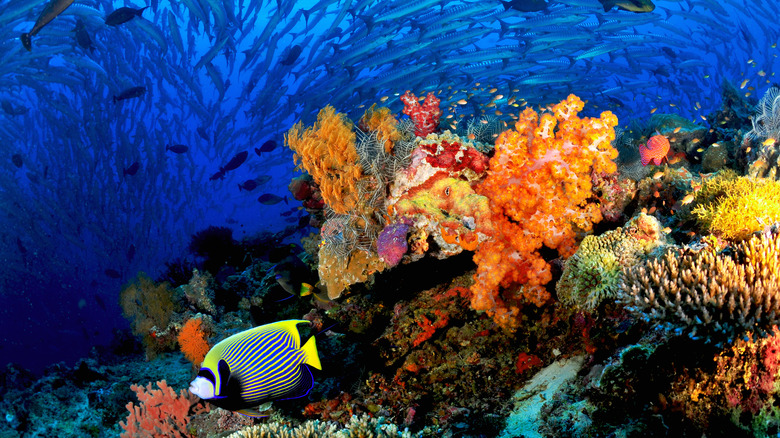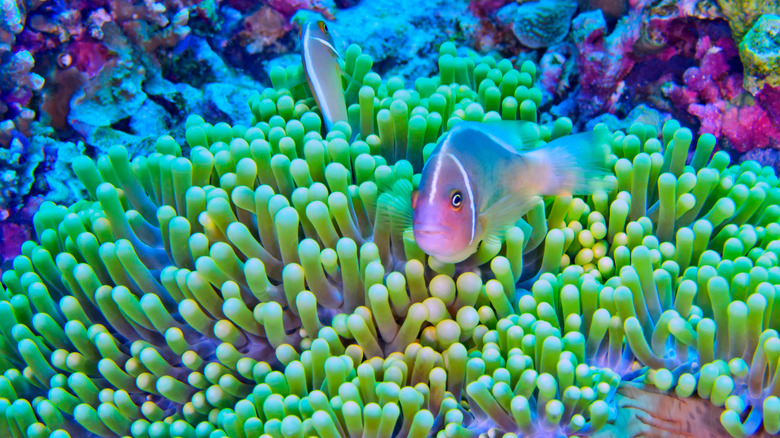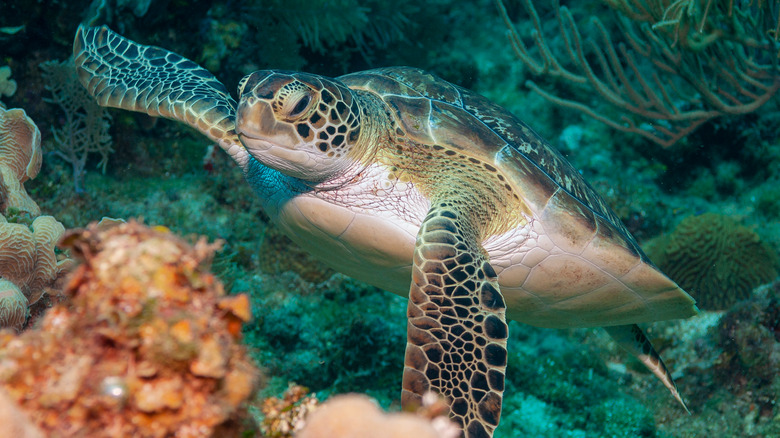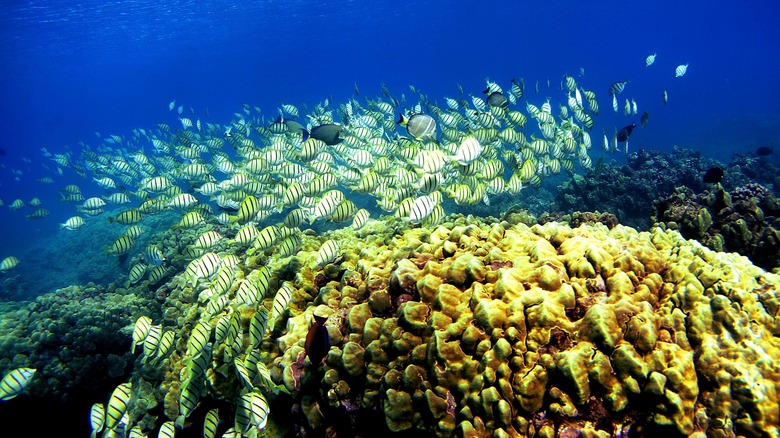15 Most Beautiful Coral Reefs In The World
Imagine yourself under the water, snorkeling or scuba diving in beautiful oceans. In front of you are colorful fish and sea life, as well as stunning coral. If you've ever seen a coral reef, you know how incredible they can be. A coral reef is an underwater area created where hard coral lives as tiny invertebrate coral polyps. When they die, they leave behind limestone skeletons, with live coral polyps on top. The structure that is created by the skeletons is a coral reef. It serves as a protected area for small fish and other creatures. In addition, there can be types of soft coral species, like the lovely sea fan.
In fact, coral reefs house around a quarter of creatures in the sea. There are thousands of fish species that live there, as well as plants and other marine life. That's some crowded housing! Many coral reefs are in jeopardy for reasons that include climate change, pollution, overfishing, tourism, and other issues. If you visit, please keep the health and safety of coral reefs in mind by floating above them and not touching them, as well as not stirring up sand below them which can smother the coral. Slow and steady movement is the way to go when you're visiting these lovely animal apartment complexes. They're important parts of our planet's ecosystem, and we've got a list of the 15 most beautiful coral reefs in the world.
Great Barrier Reef (Australia)
The Great Barrier Reef in Queensland, Australia, is the largest coral reef in the world, covering an area of 133,000 square miles. It's so big you can even see it from space! This incredible place has 3,000 individual reefs that make up the entire thing and most of it is protected. These tiny coral polyps have been living and dying here, creating the immense reef over the last approximately 500 million years.
The Great Barrier Reef isn't just home to the coral itself. Clownfish (like Nemo in the Pixar film) hide in their branches. You'll also find giant clams, manta rays, Maori wrasse, turtles, potato cod, and even whales. You've got tiny creatures, the ones that feed on those, etc. It's important to protect these species, and unfortunately, the Great Barrier Reef isn't in perfect health. It's being damaged by stressors like rising water temperatures, which can cause coral bleaching. That's when the coral expels the algae that give them their color, making them turn white-ish. That won't always kill them immediately, but it can lead to death because it can keep them from getting the nutrients they need to stay healthy.
Belize Barrier Reef (Belize)
The Belize Barrier Reef in Belize in Central America is a large reef that covers 370 square miles and holds several cayes, including Glover's Reef Marine Reserve, Half Moon Caye Natural Monument, Great Blue Hole, and Hol Chan Marine Reserve. The distinction of "marine reserves" is that they provide legal protection to keep anglers and development from damaging the reef. Unfortunately, the reef is dealing with stresses from pollution, tourists, and overfishing in the area. In addition, the temperature of the ocean has gone up, causing coral bleaching like the Great Barrier Reef. There are 65 species of coral that live here.
There are plenty of other species that reside in the Belize Barrier Reef including tarpon, barracuda, bonefish, rainbow runners, and grouper. It also provides food for the fish that live in deeper water off the reef like albacore tuna, mackerel, and marlin. The Belize Barrier Reef has been around for 10,000 years. If you're a diver, you likely know about the part of the reef called the Great Blue Hole, shown in the above image, which is the reef's most recognizable feature.
New Caledonia Barrier Reef (New Caledonia)
The New Caledonia Barrier Reef can be found in the island nation of New Caledonia, east of Australia. The reef circles the coast of the island. The country features the second-largest marine park in the world, the Natural Park of the Coral Sea, which houses 502,000 square miles of ocean and land, as well as people.
This beautiful reef is home to tons of animals. Along with whales, turtles, and sharks, there's even the manatee relative, the adorable dugong. In fact, the reef houses the third-largest population of dugongs in the world. There are almost 500 types of coral here and is now a UNESCO World Heritage Site. The New Caledonia Barrier Reef has a whopping 146 types of reef structures, and it's known for having even more biodiversity than the Great Barrier Reef. All is not perfect, though. The New Caledonia Barrier Reef, like other reefs, is threatened by commercial fishing, pollution, and climate change. That said, of all the reefs in the world, New Caledonia has a third of the world's pristine or close to pristine reefs. According to Pew Trust, only 1.5% of the world's reefs are in that condition.
Red Sea Coral Reefs (Middle East)
In the Indian Ocean, The Red Sea Coral Reef spans 1,243 miles and is over 5,000 years old. The reefs in the Red Sea have a higher tolerance to extreme temperatures in the ocean because the water movement between the sea and the ocean is minimal. That keeps the coral reefs here healthier than in other places, with very little coral bleaching and very clear water. That's largely because there isn't any river discharge and little rainfall in the region.
There are 300 types of hard coral here, and many species of fish in the reef can't be found anywhere else. You can also find 2,100 types of fish in the Red Sea Coral Reefs like the triggerfish, the sharpnosed puffer, and the long-spined porcupinefish. You can also see dugongs, turtles, spinner dolphins, and 10 different species of sharks, including the whale shark, hammerhead, thresher, and tiger shark.
Raja Ampat Islands Coral Reefs (Indonesia)
Raja Ampat (which means "four kings") Islands Coral Reefs in Indonesia encompass nearly 5 million acres of Marine Protected Area and has more than 1,600 types of fish. There are sea turtles, 17 species of marine mammals, and an incredible 75 percent of known coral species. That includes 533 species of coral. The area is part of the "coral triangle," which covers an area around the Philippines, Indonesia, and Papua New Guinea. The area has had sea life for at least 20 million years. Raja Ampat was the site of a discovery of a Raja Laut, or Coelacanth, which was thought to have gone extinct 66 million years ago.
Climate change, rising sea temperatures, farm runoff, and development are threatening the health of the coral reef. That said, there are a number of organizations working to change things. In fact, Raja Ampat's surrounding ocean area is an official sanctuary for both rays and sharks.
Tubbataha Reefs Natural Park (Philippines)
Tubbataha Reefs sit in a natural park in the Philippines in the coral triangle. If you want to visit, you'll have to go by liveaboard dive boats, which have you staying and living on the boat for your entire trip, returning there after each dive instead of a hotel. There is no way around it, but it will allow you to focus on diving alone.
The reef is a UNESCO World Heritage Site and is currently in good health due to conservation efforts. It has over 600 species of fish and 360 different kinds of coral, as well as manta rays and hammerhead sharks. In fact, the reef holds almost 90 percent of the coral types in the Philippines. There are a number of endangered and threatened species including the Napoleon wrasse, as well as green and hawksbill turtles. If you want to go, book early because the dive season at Tubbataha Reefs runs from March through June only.
Maldives Coral Reefs (Maldives)
The Maldives Coral Reefs are located in the Indian Ocean and feature over 2,000 coral species. Endangered species like manta rays, whale sharks, and green turtles live in and around this reef. You'll also find Napoleon wrasse, barracuda, and batfish. This is a good reef for beginning divers, as many of the reefs are really close to shore, though boats can take more experienced divers to different locations.
These coral reefs set around the area's 26 atolls are in danger. Over 60 percent (some places up to 90 percent) of the reefs here are experiencing bleaching as of 2016. Save the Beach Maldives has been working to preserve and rehabilitate the reefs. Along with an eco-tourism company called Secret Paradise Maldives, they have a conservation tour for visitors. With coral reef tourism hitting $35 billion as of 2022, it's important for guests to know what's happening — and as always, to be conscious of not touching coral or damaging it in any way.
Solomon Islands Reefs (Solomon Islands)
The Solomon Islands, which are made up of over 900 individual islands, are located in the Pacific Ocean in the coral triangle. Around half of the islands here aren't inhabited. With 494 species of coral, the reefs themselves cover 1386 square miles, and the area supports 1,371 species of fish and larger creatures like whales, dugongs, and dolphins. There are coral gardens with fan and black coral species.
If you choose to go diving here, there are World War II shipwrecks to discover, as well as lava tubes. In fact, the Solomon Islands are the site of one of the most active underwater volcanoes, Karachi, with the first recorded eruption happening in 1939. Unfortunately, like so many others around the world, the Solomon Islands reefs are suffering from coral bleaching due to rising ocean temperatures, overfishing, deforestation runoff, and infestations.
Elphinstone Reef (Egypt)
The Elphinstone Reef is located in Egypt near the city of Marsa Alam in the southeast and is home to an incredible amount of underwater life. There are 1200 types of fish and 200 species of coral. There are even 44 species of sharks in the area, including hammerheads and oceanic white tips, and you can swim into dogtooth tuna and barracuda. There are also plenty of shipwrecks if you plan on diving here. The sharks, particularly the hammerheads and oceanic white tips, are a big draw for divers.
The reef itself is one of the smaller ones on the list, at only 1148 feet long and up to 131 feet wide, but one feature is an archway that appears to have a sarcophagus-shaped formation inside, with an accompanying legend that an unknown pharaoh is buried here, under the sea. The reef is pretty healthy, with no coral bleaching recorded as of 2019.
Somosomo Strait Reef (Fiji)
The Somosomo Straight Reef is set between Taveuni Island and Vanua Levu in the Republic of Fiji. The island nation is known as the soft coral capital of the world, and the reef itself is 20 miles long.
The Somosomo Strait is home to dive sites like the Rainbow Reef, which is full of spectacularly colorful soft coral, the Great White Wall, which takes you through a cave to see a wall full of white (and blue) coral, and The Zoo, which has a ton of colorful fish like clown triggerfish and colorful nudibranch, as well as white-tip reef sharks. In fact, there are over 1500 fish species and 390 coral species, many of which are the soft coral the reef is famous for. You'll also be able to see eels, octopuses, turtles, and more. There have been several coral bleaching events recorded, though it's been able to recover.
Bonaire Reef (Bonaire)
Bonaire Reef National Marine Park in Bonaire in the Dutch Caribbean is the oldest marine reserve in the world and has been designated as a UNESCO World Heritage Site. This reef is famous for the conservation efforts that have helped keep the place healthy, including growing and replanting coral species like staghorn in nurseries and then planting them in the reef. The Bonaire Reef has been around for between 3 and 4 million years, stretching 226 miles of the island's coast. It's home to 65 hard coral species and almost 700 fish species like trumpetfish and parrotfish. If you love turtles, this is a great reef to visit. It houses endangered turtle species like the hawksbill, green, and loggerhead.
This is also a great place for snorkeling (and scuba diving) because the water is calm and the reef isn't that far from the coast. To dry off a bit, then visit the Lac Bay Mangrove Forest, which helps protect the reef from storms. Visiting this place helps support the island's sustainable tourism industry.
Sipadan Reef (Borneo)
The Sipadan reef off Sipadan Island is located in Malaysian Borneo and was featured in the "Ghosts of the Sea Turtle" documentary by the late Jacques Cousteau. The island is actually an extinct volcano that pokes out 1,970 feet above the water. In fact, the island itself comes from the remains of hard coral that grew on top of the volcano over time. It has a turtle nesting ground that you can see if you dive there. You'll find barracuda, white-tipped reef sharks, the very strange, but cool-looking bumphead parrotfish, as well as batfish.
This place has hundreds of species of coral and around 3,000 species of fish. If you dive there, you can check out the macabre-sounding Turtle Tomb, which is a cave that houses the remains of sea turtles that have gotten lost and died there, as well as a dolphin skeleton. In a 2014 survey of the Sipadan reef sites, conducted by the National Reef Check Survey Programme, the reef was rated somewhere between fair and excellent conditions and almost none were in poor condition.
Bunaken National Marine Park (Indonesia)
The Bunaken National Marine Park is located in North Sulawesi, Indonesia, right in the middle of the Coral Triangle. It covers 309 square miles, with three percent of the park actually on land. In 1991, the park was established to help protect the local marine life, including dolphins, whales, turtles, dugongs, and coelacanths. That's in addition to the 390 different species of coral and 2,000 fish species. There are also giant clams. In fact, seven of the eight species that exist of giant clams live in the waters of Bunaken Park.
The island itself and the coral reef were created by a volcano somewhere between 1.5 and 5 million years ago, though the volcano is inactive. The reef at Bunaken was surveyed in 2014 and again in 2018 by a group of coral reef ecologists from the University of Queensland in Australia with collaborators. They found the coral in the area continued to be stable, according to the report, with minor bleaching.
Roatán Reef (Honduras)
The Roatán coral reefs are located in Honduras and make up part of the Mesoamerican Reef, which is the second largest in the entire world. There has been an effort to help preserve the reef by working to reduce overfishing, disease, and pollution. They are working to reduce algae growth from sewage, which can kill coral.
The entire Mesoamerican reef is 625 miles long, making it the longest reef in the Western Hemisphere. There are over 60 stony coral species in the reef, as well as over 500 fish species. Even cooler, the entire reef has the biggest manatee population in the world and is home to the Roatán Barrier Reef whale sharks, which are the largest fish in the world. The Roatán reef is also protected by the mangrove trees, which provide food and protection for some of the species.
Hanauma Bay Nature Preserve (Hawaii)
Hanauma Bay is located in Hawaii, off the island of Oahu near the city of Honolulu. There are over 450 types of fish, green sea turtles, octopuses, and over 70 different types of coral. The bay, created 32,000 years ago, is the flooded crater of a volcano and covers around 101 acres.
Over the years of tourism, the bay's coral reefs and local fish have been affected by hordes of visitors who show up annually. However, during the pandemic lockdown, slowing these numbers, the health of the bay began to improve. One of the things damaging the coral reef and the local seagrasses is the oxybenzone sunscreen worn by swimmers. Again, the difference in the amount of the substance in the water was noticed during lockdown. If you dive here, also keep in mind that the area of the reef known as the Witches Brew is dangerous when the current gets strong.
Regardless, always wear reef-safe sunscreen diving at any of the aforementioned locations. You're welcome to enter, just whip your feet — for the sake of the reef and its inhabitants.
